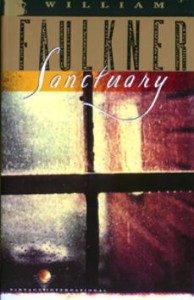 A Barely Coherent Mystery
A Barely Coherent Mystery
Faulkner, William (1931). Sanctuary. New York: Vintage.
Often billed as Faulkner’s commercial whodunit, this novel hovers on the edge of unintelligibility. But, it’s a “classic,” so what do I know.
Temple Drake, a young, well-off college student in Prohibition-era Mississippi, is a wild party girl. Her drunken boyfriend takes them both to a bootlegger deep in the woods to get some drink. He becomes fall-down drunk, gets beaten up by the other men there, and leaves, abandoning Temple. She gets raped, and in the commotion, a black man, Tommy, gets killed. Popeye, the bad guy, takes Temple to a whore house in Memphis, where he rents her out. Meanwhile, another black man, Lee, is accused and jailed. His lawyer, Horace, believes evidence-based reasoning will free him, but Lee is wrongly convicted when Temple lies on the stand. Lee is burned alive by an angry crowd. Horace skulks off, defeated. Temple remains oblivious.
That could, in principle, be an interesting mystery story, but there are two major problems with Faulkner’s telling of it. One is that characters are generally unmotivated. They are crazy, drunk, insane, or just weird, so they can do and say all sorts of surprising, unexpected things, because they are not normal people. Faulkner is known for his characterizations of irrational, almost sub-human animals that inhabit his fictional Southern landscape, but that doesn’t make them interesting or believable. When there is little causal connection between events in a story, you don’t have a story, just a collection of scenes. Some people don’t mind that, but it doesn’t work for a mystery.
Secondly, Faulkner uses a writing style that deliberately obfuscates the story line, the characters’ motivations, and even their identities. Almost every scene starts off with a series of unresolved pronouns so you don’t know, can’t know, what the hell’s going on until you read a few more pages and deduce (if you are a close reader) which characters are even in the scene, let alone what they are doing there. Example, from the opening of chapter 7:
“From somewhere beyond the lamplit hall she could hear the voices – a word; now and then a laugh; the harsh, derisive laugh of a man easily brought to mirth by youth or by age, cutting across the spluttering of frying meat on the stove where the woman stood.”
That’s a charming Faulknerian sentence except the reader does not know who “she” is or who “a man” is, or who “the woman” is. We don’t know where the description is located in time or space, or why. It can be deduced by further reading, but when every scene opens with such deliberate misdirection, it seems that Faulkner has contempt for his reader.
On top of that, all the scenes and chapters in the book have been put through a shredder then reassembled in random order, (Faulkner admits as much in his personal papers), so there is almost no chronological order to anything that happens. The result is a series of vignettes that, while often intriguingly written, do not add up to a coherent story, let alone an enjoyable one. If you insist on reading this book, you should first print out a list of characters (such as found on Wikipedia), so you have a chance at understanding. Unless you enjoy crossword puzzles.
